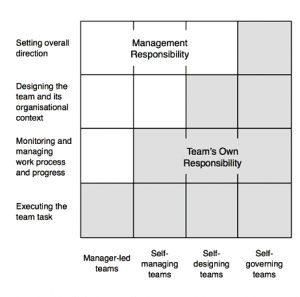What do we mean by the self organizing teams? Are these teams really necessary? Do organization require them. The answer is YES.
There are simple reasons why we require them
- To deliver more business value
- Learn faster
- Achieve better results
- Work with more motivation and fun
What are Self-Organizing Teams?
In many cases real teams get confused with so-called co-acting groups. Whereas co-acting groups consist of people working in proximity to one another but not depending on what the others do to complete their respective jobs, real teams have four features:
- Joint tasks to fulfil a mission;
- Clear boundaries in terms of information flow, alignment with other organisational units, resources etc;
- Authority to self-manage;
- Stability over some reasonable period of time.
There are different types of teams we can have: 
Figure Authority Matrix
- Manager-led teams that leave team members only the authority for task execution while managers monitor and manage work processes, design the context and set the direction. From our point of view, many expert groups in functional silos as well as traditional project management “teams” are practical examples of this set-up;
- Self-managing teams put members not just in charge for task execution but also for managing their progress;
- Self-designing teams give members the authority to modify the design of their team and/or aspects of the organisational context in which they operate. Most real management teams are in this position as well as some Scrum teams especially when Lean/Agile is scaled;
- Self-governing teams have responsibility for all four core functions as shown by corporate boards of directors, worker cooperatives or start-ups.
Self-organisation is not just about the whole team within its specific organisational context. Each team member has to self-organise as well to figure out what to do and how to do it. And every day, everyone on the team has to coordinate his or her self-organisation with the rest of the team. In order to synchronise, we run regular meetings such as the “Daily Standup”, “Operations Reviews” or “Retrospectives”.
Creating Self-Organizing Teams?
Its a combined efforts of Scrum Master, senior management and organization
Scrum master has to train,coach and mentor. Senior management should support and make sure that the team sustains and organization should provide necessary infrastructure, training and incentives to keep the teams motivated. So creating these teams is basically a three step process
- Coach
- Train
- Monitor
Teams are not static. They continuously change over the time. So building the team is continuous process and we need to repeat the same if team’s composition changes over the time.
Now check: Anti Google Gravity


